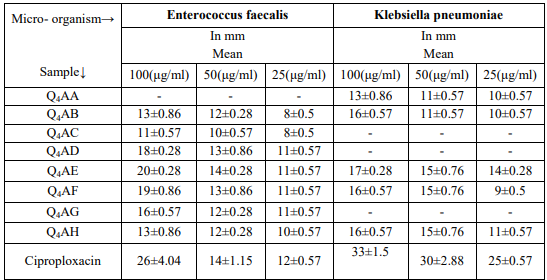Synthesis, Characterization and Antimicrobial Evaluation of Schiff’s Bases of 1-Amino-7-hydroxy-2-methylquinoline-4(1H)-one
Keywords:
Resacetophenone, 4-quinolone, acylchloride, pyridine, Schiff’s bases, well diffusionAbstract
We have synthesized eight Schiff bases of 1-amino-7-hydroxy-2-methylquinolin-4(1H)-one named as Q4AA-Q4AH by refluxing (Q4A) with substituted aromatic aldehydes in ethanol for 5-7 hrs. The final test compounds has purified and characterized by IR, 1HNMR and Mass Spectral studies. M.P. of these compounds was confirmed by open capillary method instrument chemline Cl 725. They have evaluated for antibacterial activity. Compounds were active against Klebsiella pneumonia and Enterococcus faecalis. Test compounds, such as Q4AD, Q4AE and Q4AF showed moderate activity against gram positive micro-organism while Q4AG and Q4AF showed activity against gram negatives organism lower than standard ciprofloxacin. Their antimicrobial activity was evaluated by wells diffusion method.
References
A. Foroumadi, Ghodsi Sh, S. Emami, S. Najjari, “Synthesis and antibacterial activity of new fluoroquinolones containing a substituted N-(phenethyl)piperazine moiety,’’ Bioorg. Med. Chem. Lett., 16:3499–3503, 2006.
ChG Noble, FM . Barnard, A. Maxwell, “Quinolone- DNA Interaction: Sequence-Dependent Binding to Single-Stranded DNA Reflects the Interaction within the Gyrase-DNA Complex,’’ Antimicrob. Agents Chemother, 47, 854–862, 2003.
S. Verma, A. K. Sirbaiya and S. N. Pandeya, “Antimicrobial activity of Schiff base of ciprofloxacin,” Der Pharmacia Sinica, 4(1): 1-9, 2013.
D.T.W. Chu and P.B. Fernandes,” Recent development in the field of quinolone antibacterial agent,” in advances in Drug Research, Testa B(ed.) , London, Academic Press, vol. 21,pp. 39-144 ,1991.
R. K. Shandil, R. Jayaram, P. Kaur, “Moxiflocin, Ofloxicin, Sparfloxacin and Ciprofloxacin against Mycobacterium tuberculosis:Evaluation of in Vitro and Pharmacodynamic Indices that best predict in Vivo Efficienc,” Antimicroial. Agents Chemotherapy, vol. 51, Issue 2, 576-582, 2007.
Dohrten, Diedrich, U. S. Pat, 1, 1932, 862, 361.
Tirasek et. al.,Cersk. Dermatol, 38, 1966, 41.
CT Supuran, A Casini and A Scozzafava, “Protease inhibitors of the sulphonamide type:Anticancer, anti-inflammatory and antiviral agent,” Med. Res. Rev. vol.23, Issue 5 , 535-558, 2003.
N.K. Mak, TW Kok, RN Wong, SW Lam, “Photodynamic activities of sulfonamide derivatives of pophycene on nasopharyngeal carcinoma cells,” J. Biomed. Sci., 10: 418-429, 2003.
PGD Benedetti: Advances in drug research. Testa B. Academic Press. London and New York, Vol. 16, 227-279, 1987.
T. Hokelek, H. Necefoglu, “Crystal structure of [triaqua(salicylato)(nicotinamide)zinc(II)] salicylate,” .Analytical Sciences, vol. 17, 1241–1242, 2001.
W. Baker, “Molecular rearrangement of some o-acycloxycetophenone and the mechanism of the production of 3-acylchromone,” J. Chem. Soc., 1381-1389, 1933.
R.H., Erickson, Jr. Natalie., k.J. Bock, “(aminolkoxy)chromones. Selective sigma receptor ligand,” J. Med. Chem. 35, 1526-1535, 1992.
Nuss baumer, P.,Lehr , A.J. Billich, “2-Substituted 4-(thio)Chromenone 6-o-sulfamates: potent inhibitors of human steroids sulfatase,” Med. Chem. 45, 4310-4320, 2002.
Billich,A.,Nussbaumer ,P., Schreiner,E., Schuster,I.,1999.preparation of Chromanone and Thiochromanone Derivatives as Steroid Sulfatase Inhibitors. Patent WO 9952890.
R. I. H. Al-Bayati and M. F. Radi, “Synthesis of novel 2-quinolone derivatives,”African Journal of Pure and Applied Chemistry, vol. 4, Issue 10, 228-232, 2010.
Saied M E Khalil, “Metal complex of Schiff base ligands derived from 4-hydroxy -2(1H) quinolone and ethylnediamine or 1, 2-propylenediamine,” Indian journal of chemistry 33A (9), 830-836, 1994.
S.Magaldi, “Well diffusion for antifungal susceptibility testing,” International journal of infectious diseases, 8, 39-45, 2004.
A. Sen, A. Batra, “evaluation of antimicrobial activity of different solvent extracts of medicinal plant:Melia Azedarach L,” International journal of current pharmaceutical research, Vol. 4 Issue 2, 67-73, 2012.
H. jahagirian,Md. J. haron, L. afsah-hejari, “well diffusion method for evaluation of antibacterial activity of copper phenyl fatty hydroxamate synthesided from canola and palm kernel oil,” Digest Journal of Nanomaterial and Biostructure,: Vol. 8 Issue 3, 1263-127, 2013.
Systematic organic chemistry, by W.M. Cumming, 91, 1937.

Downloads
Published
How to Cite
Issue
Section
License

This work is licensed under a Creative Commons Attribution 4.0 International License.
Authors contributing to this journal agree to publish their articles under the Creative Commons Attribution 4.0 International License, allowing third parties to share their work (copy, distribute, transmit) and to adapt it, under the condition that the authors are given credit and that in the event of reuse or distribution, the terms of this license are made clear.





